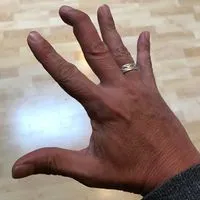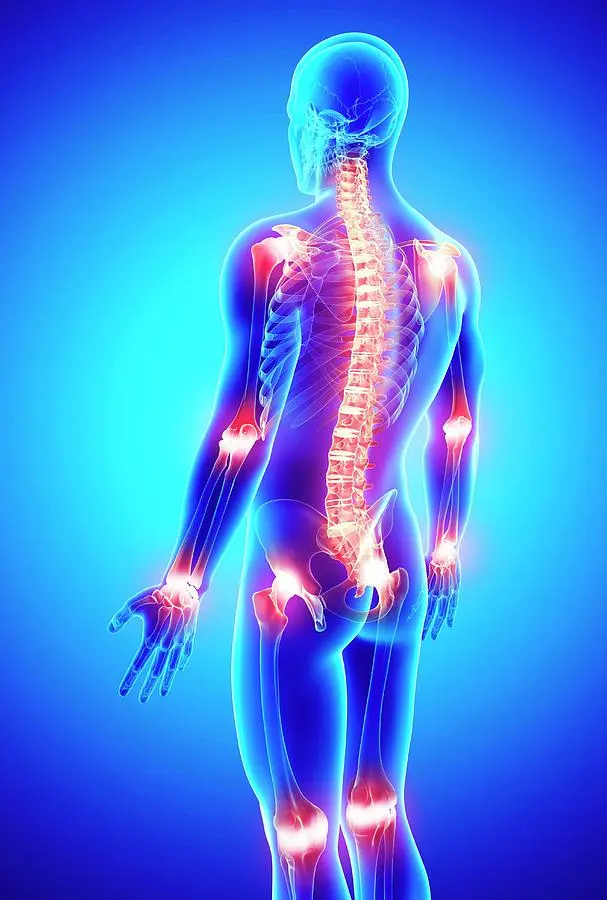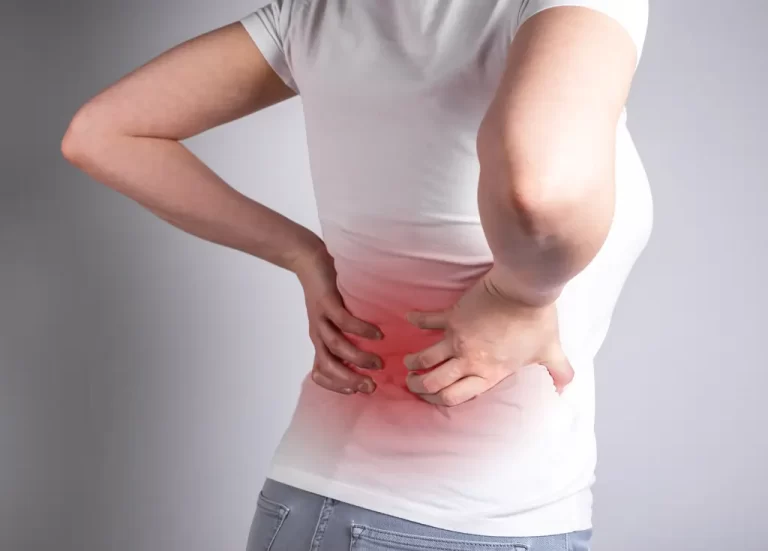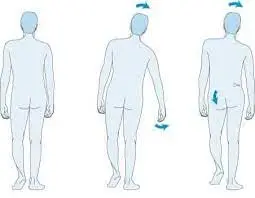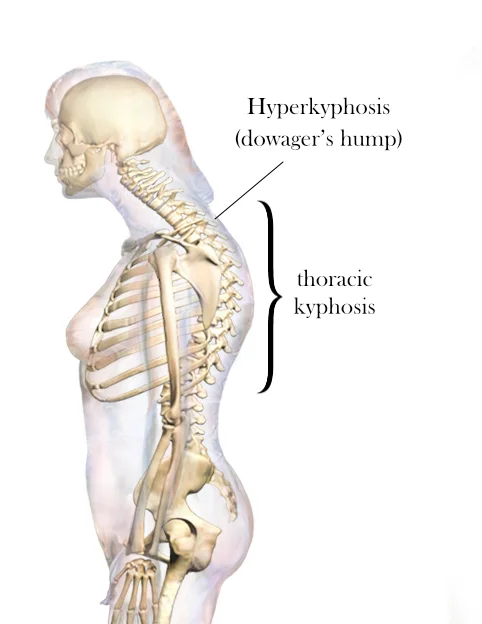Mallet Finger
What is a Mallet Finger?
“Mallet finger,” also known as “baseball finger,” is a common injury affecting the extensor tendon of the finger. This injury typically occurs when an object forcefully strikes the tip of a finger, causing sudden flexion of the distal interphalangeal (DIP) joint.
An injury to the thin tendon that straightens a finger or thumb’s end joint is known as a mallet finger. For the fingers, this joint is known as the distal interphalangeal (DIP) joint, and for the thumb, it is known as the interphalangeal (IP) joint.
The injury can occur when the tip of a finger or thumb is struck by an unyielding (rigid or solid) item (like a baseball) and is forced to bend beyond its intended length. The damage prevents you from being able to straighten the tip of your finger or thumb on your own, which causes the tip to be bent.
Baseball players frequently suffer from a mallet finger, which is an injury to the tendon at the tip of the finger. Your finger can droop at the top if you are unable to straighten it all the way. Ice and splinting are the usual forms of therapy. Rarely is surgery performed. In the event that you have a mallet finger, you should see a physician right away.
A mallet finger is an injury to the tendon that straightens the tip of your finger (or thumb). It’s also known as the baseball finger or drop finger. Endons connect your muscles to your bones to give you support and movement. The tendon may rip or separate from the finger bone in the event of an accident. You could occasionally hurt both your tendon and your finger bone. Mallet finger causes discomfort, drooping at the tip, difficulty stretching the finger, and a bruised or bloated appearance.
In sports like baseball, basketball, or football, a mallet finger is an injury that commonly happens when you try to catch a hard ball and it strikes your extended fingertip. An injury frequently affects a finger on your dominant hand, which is the one you use the most. Extensor avulsion fractures and distal extensor tendon ruptures are referred to as “mallet fingers.” One of the two causes the distal interphalangeal (DIP) joint to become inflexible.
Injury from mallet fingers are:
- Named for the flexion deformity of the fingertip that results, like a hammer or mallet.
- caused by interference with the phalanx’s extensor mechanism at the distal interphalangeal joint.
- The distal interphalangeal joint’s forceful flexion is typically the cause of them.
- causes the distal phalanx to be unable to grow.
- When the extensor tendon also causes the distal phalanx to avulse, this results in a mallet fracture.
Since the optimum course of therapy for mallet finger injuries is unknown, a multidisciplinary team is ideally suited to handle these cases.
For minor injuries, conservative care using splints is frequently utilized (outcomes are unknown)
Surgery is frequently performed (with subpar outcomes).
Anatomy
The hand and forearm include the muscles responsible for moving the thumb and fingers. These muscles send tendons through the wrist to join the little bones in your fingers and thumb, enabling you to move them.
- The fingers on top of the hand are straightened by the extensor tendons.
- The fingers on the palm side of the hand are bent by the flexor tendons.
Through a very complex arrangement, the extensor tendons straighten the thumb and fingers. An aponeurotic sheet surrounds a plexus of tendons that make up the extensor apparatus. The dorsal area of the hand and fingers contains the extensor tendons. These tendons are responsible for extending the fingers and wrist.
Epidemiology
Mallet finger injuries and other injuries involving the terminal extensor tendon are frequent. 5.6% of hand and wrist injuries are related to the terminal extensor tendon. Injuries from mallet fingers:
- Typically take place during work or at sporting events
Are often observed in young to middle-aged males, and on occasion in women who are older as well. Men who sustain injuries with a mallet finger are 34 years old on average. Women are 41 years old on average. - It is more prevalent in ball sports when the ball strikes an outstretched fingertip. This results in a disruption of the extensor tendon by forcing the distal interphalangeal joint into a flexion position.
Lower impact injuries, such as an older person “jamming” their finger while doing daily tasks like tucking in bedsheets or putting up socks, can also result in terminal extensor tendon injuries.
The dominant hand’s ring finger and long or middle finger are the digits that are most frequently impacted.
Causes of Mallet Finger?
Ruptures of the distal extensor tendon occur in mallet finger injuries. When a finger is actively extended and its distal phalanx is driven into flexion, such as happens in ball sports when a ball strikes the tip of an extended finger, the rupture occurs.
Originating in the forearm, the extrinsic extensor tendon crosses the metacarpophalangeal joint, attaching indirectly to the proximal phalanx before ending at the distal phalanx. The digits’ ability to extend is due to these tendons.
An interruption of the extensor tendon results in a mallet finger injury. When a distal phalanx avulsion fracture results from a tendon injury, a mallet fracture happens.
The available data is in favor of nonoperative therapies; nevertheless, injuries must be treated quickly to prevent unfavorable results.
A mallet finger injury results from a hard object striking your extended finger or from trauma to the tip of your finger, such as getting stuck in a door.
Symptoms of Mallet Finger?
Following the first injury’s discomfort, you could feel:
- Bruising and swelling.
- Redness.
- An inability to extend your fingertip straight.
- Sensitivity.
- A split nail on a finger.
- Blush under the nail bed.
- Usually, the finger hurts and is bruised and swollen.
- The fingertip will distinctly droop.
- It will only straighten if you use your other hand to press the fingertip up.
Possibility of Infection
If there’s blood under the nail or if the nail is broken, you should definitely get help right once. This might indicate an open fracture (where the wound extends down to the bone) or a cut in the nail bed where the finger bone is damaged. You run the danger of being infected from these kinds of injuries.
Initial Care
Apply ice to your finger very away to ease discomfort minimize swelling, and keep your hand above your heart.
Pain relief options include acetaminophen and non-steroidal anti-inflammatory medications (NSAIDs), such as naproxen and ibuprofen.
For the tip of the digit, you can manufacture a well-padded splint, but be careful that it doesn’t get in the way of the undamaged joints’ range of motion.
Obtain a hand surgeon’s evaluation as soon as you can, preferably within a week after the accident.
- If there is a traumatic reason, a reported inciting incident will occur.
- The finger is first swollen and sore around the DIP joint.
- The issue may not hurt too much if the tendon itself is ruptured. If a piece of the bone is severed, it is frequently somewhat more painful and swollen. The finger’s end is bent and cannot be freely straightened. On the other hand, straightening the DIP joint is a simple task.
Differential Diagnosis
- Swan Neck Deformity
- Boutonniere Deformity
Diagnosis
Physical Examination
To guarantee that a mallet finger injury heals as much as possible, medical care is necessary. Within a week following the injury, the majority of doctors advise getting treatment. There have been instances, too, when the finger recovered fully even if therapy wasn’t started for up to a month following the accident.
Your doctor will check your thumb or finger after talking to you about your symptoms and medical history. Your doctor will hold the injured finger while doing the examination and ask you to straighten it on your own. The mallet finger test is the term for this.
- If there is a traumatic reason, a reported inciting incident will occur.
- The finger is first swollen and sore around the DIP joint.
- The issue may not hurt too much if the tendon itself is ruptured. It is often a little bit more swollen and painful if a portion of the bone is torn off.
- The finger’s end is bent and cannot be freely straightened. On the other hand, straightening the DIP joint is a simple task.
Diagnostic Procedures
X-rays
It’s possible that your doctor may request X-rays of the damage.
An X-ray will show if there is a bigger bone fracture or if a piece of the distal phalanx was ripped away during the tendon rupture.
An X-ray can also reveal whether the damage dislocated the joint’s bones, which may need to be fixed surgically.
Additional imaging tests, such as MRI or ultrasound, can occasionally provide more details.
Treatment of Mallet Finger
- Untreated mallet finger injuries usually cause the affected fingertip to become rigid and deformed. In the worst situation, a mallet finger left untreated can cause a swan neck deformity, which is a major deformity with poor function.
- In 2018, a comprehensive assessment of high-quality data was carried out to assess the efficaciousness of therapy therapies for mallet fingers. It was determined that both surgical and non-surgical therapy produce outstanding results and that each patient should have a customized option of therapeutic intervention.
- Most mallet finger injuries, however, may be managed with a splint and no surgery if they are addressed quickly.
- The cartilage that regulates bone formation may be damaged by mallet finger injuries in youngsters. In order to prevent stunting (inadequate development) or deformity of the finger, a physician must carefully assess and treat this injury in children.
- Healing requires both short-term and long-term medical care.
- As soon as an injury occurs, you ought to:
- After wrapping your finger in a towel, place an ice pack on it.
Touch your heart with your finger. This can lessen the discomfort and keep the swelling in check.
If necessary, take over-the-counter pain relievers. - The goal of long-term therapy is to mend your tendon by placing your fingertip in a splint and leaving it there for at least six weeks. After a week or two of splinting, your doctor could request another X-ray to check on the healing process and the proper placement of any bone fragments that were peeled out. After that, you must wear your splint all day and all night for at least six weeks. In order to clean the splint and the finger, the splint may be gently removed during this period. However, to avoid further damage, you should refrain from sports and physically demanding activities.
- Splints come in a variety of varieties. Discuss the optimal type with your healthcare physician. Once a day, you must wash and dry the splint, being sure to keep your finger straight during the process. Additionally, three to four times a day, you should freeze your splintered finger for ten to twenty minutes.
- A little pin may need to be surgically inserted into your finger by your surgeon to maintain the joint straight while it heals if your mallet finger injury is more complicated.
Nonsurgical Treatment
may get splinting nonstop for about six weeks, then at night for an additional six weeks.
This usually causes the finger to recover satisfactorily and regain its range of motion.
To make sure the patient is aware of the need to preserve DIP joint extension, patient education is crucial.
For the first six weeks, constant splinting is essential.
The procedure is disturbed and needs to be restarted if the splint is taken off and the finger is allowed to flex.
The splint needs to be worn all the time, including while taking a shower.
The tendon ends should be able to move as closely together as feasible while the splint holds the DIP joint in full extension. Scar formation heals the tendon as it heals.
A program for carefully weaning out of the splint is put in place until the tendon is strong enough to hold the fingertip straight. If the patient decides to resume playing sports while wearing your splint, you must teach them to securely fasten it using sports tape so that it doesn’t come loose.
Splinting
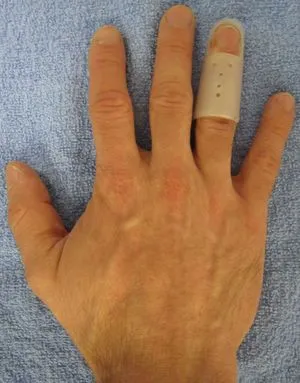
The most common treatment for mallet finger injuries is splinting. Until the fingertip heals, a splint keeps it extended and straight.
The splint needs to be worn full-time for six to eight weeks in order to recover finger function. This implies that it needs to be put on while taking a bath and then gently taken off. But if the thumb or DIP joint is kept straight with the other hand for the entire time the splint is off, it can be taken off for bathing. You may need to wear the splint for a longer amount of time if there is any drooping of the fingertip, as this will interfere with recovery.
Long-term splint usage can irritate the skin, therefore your doctor may discuss with you how to regularly examine your skin for issues. In order to track your progress throughout the course of the eight weeks, your doctor could also arrange for extra appointments.
You may eventually wear the splint simply at night or less often. Acceptable function and appearance are often the outcomes of splinting treatment; nevertheless, many patients do not achieve complete fingertip extension.
Some individuals find the splinting program quite challenging. In these situations, the physician could choose to place a temporary pin across the fingertip joint to provide it with support for eight weeks.
Surgical Treatment
If the joint is out of position (subluxated) or there is a big piece of an avulsion fracture, your doctor may consider surgical treatment. In these situations, the fracture is repaired surgically, and the joint is realigned while the fragments of bone are held together with pins until the wound heals.
As previously indicated, if you are unable or unable to wear a splint for eight weeks, surgery may potentially be an option. Like an internal splint, straightening the joint can be achieved by pinning it, although doing so increases the possibility of surgical complications.
Surgery is not frequently used to treat mallet fingers if there is no fracture and the joint is properly positioned. Due to the tendon’s extreme thinness, suture repairs are challenging, if not impossible. Tendon grafts, which involve transferring tendons from one area of the body to the injured finger, are difficult and occasionally unsuccessful procedures. Thus, the preferred course of therapy is typically splinting.
Fusion of the joint may be explored in cases with chronic mallet fingers, where the damage has been there for several months or years. A joint fusion fixes a joint’s mobility and fixes it in a useful, long-term position. For both function and beauty, the fusion of the DIP and IP joints is frequently completed very straight.
- When there is a significant bone fragment when the fingertip has somewhat shifted, or when there is a laceration, surgery is necessary to restore a mallet finger.
- Following mallet finger surgery, rehabilitation primarily aims to preserve the range of motion in the remaining joints and avoid stiffness from inactivity.
- According to Lin et al. (2018), the average DIP joint extensor lag is 5.7° following surgical intervention and 7.6° following conservative therapy. Incorporating this into patient education is crucial since it will guarantee that patients have reasonable expectations for the results of their therapy.
Physical Therapy Treatment
A splint is typically worn full-time for a duration of 6–8 weeks. After that, workouts can start to progressively expand the fingertip’s range of motion. At this point, decrease the client’s splint wear time progressively. Following immobilization, the finger often regains its maximum range of motion and strength within three to four weeks.
Complications
Following either nonsurgical or surgical therapy of mallet fractures, any of the following problems may arise:
- Physical examination revealed residual extensor lag.
- Swan neck abnormalities (where the proximal interphalangeal joint remains hyperextended and the distal interphalangeal joint becomes abnormally flexed owing to a disruption of the volar plate induced by the damaged extensor tendon).
Prevention
By exercising caution when participating in sports involving hard balls, you may try your best to prevent injuries to your mallet finger. However, these injuries are frequently caused by incidents that aren’t always avoidable.
Prognosis
- What is the prognosis for those who have a mallet finger?
Without surgery, the majority of patients who sustain a mallet finger recover and regain full or almost full use of their fingers. - Is it possible for a mallet finger to recur after treatment?
An injury is a mallet finger. As with many injuries, a mallet finger might recur after healing. - What would happen if you didn’t treat a mallet finger?
If you fail to treat your mallet finger injury, it may become inflexible and perhaps unworkable. An issue with the form of your finger like a swan’s neck might arise. - Your child’s finger could not grow normally if they have a mallet finger and are not treated.
Conclusion
Mallet finger is an uncomfortable condition that has an easy cure. Usually, after three or four months, you should be back to your regular self. As soon as you are wounded, get in touch with your doctor. Sometimes folks put off getting checked out because they think the injury isn’t significant.
This may prolong the time that you need to wear a splint and slow down the healing process. As directed by your physician, wear your splint for at least six weeks, take your prescription painkillers, and perform your finger exercises. Keep in touch with your healthcare practitioner and share any new issues or worries you may have.
FAQs
Can a mallet finger be treated at home?
A mallet finger requires medical attention; it won’t go better on its own. Because of the possibility of pressure regions and to preserve the integrity of the skin, we strongly advise against self-managing by strengthening the joint at home. Always consult with a hand therapist.
How should one prevent a mallet finger?
Although you should receive treatment for a mallet finger, you should be able to carry on with your regular activities. Sports should be avoided until you’ve fully recovered. Depending on how much you depend on the damaged finger for your profession, you might need to take a few days off from work.
Is hammer finger typical?
A frequent injury known as a “mallet finger” results from an impact that tears a fingertip’s tendon. Without surgery, most injuries may be effectively addressed. It’s advisable to get medical attention from a doctor as soon as possible if you have an injury to your finger and are unable to straighten the tip.
How painful is a mallet finger?
You will discover that the affected finger stays bent at the final joint no matter how hard you try. Pain and Swelling: You could have pain, sensitivity, and swelling near the injured joint after a mallet finger injury. Depending on the severity of the damage, this pain may be minor or severe.
Can a mallet finger be healed?
Without surgery, the majority of mallet finger injuries are curable. For the majority, non-removable finger splinting can be used as a full treatment until the bone closes the fracture or the tendon heals on its own. Ice therapy can be used to reduce swelling if there isn’t a cut or laceration.
Does a mallet finger heal completely?
The majority of mallet wounds recover completely in eight weeks or less. But it can take a few months for your symptoms to fully go away. These may consist of soreness or discomfort, stiffness, weakened muscles, and edema. If you smoke or have diabetes, your injuries can heal more slowly.
Mallet finger: is it urgent?
Unless the finger’s skin is seriously wounded, a trip to the emergency department is typically not necessary in cases of mallet finger. To start therapy, though, you should visit your physician or hand surgeon as soon as possible, preferably within a few days or weeks.
What is the unique test for the mallet finger?
Your doctor will hold the injured finger while doing the examination and ask you to straighten it on your own. The mallet finger test is the term for this. Your doctor will test your ability to straighten your fingers without help using a mallet.
What signs of mallet finger are present?
Your fingertip will bend if you have a mallet finger, and you won’t be able to straighten it. Additionally, your finger could be sensitive or
uncomfortable. bruised or swollen.
What is Mallet Finger’s other name?
An extensor tendon injury at the finger joint that is the furthest away is referred to as a mallet finger, hammer finger, PLF finger, or Hannan finger. As a result, the fingertip cannot be extended without being pushed.
What differentiates a trigger finger from a mallet finger?
Despite having a similar appearance, the Mallet Finger and Trigger Finger are two very distinct conditions. Unlike the Trigger Finger, which is caused by overuse, the Mallet Finger causes injury. The bent finger posture associated with Trigger Finger causes inflammation or thickening of the tissue around the tendon.
Which tendon is the mallet finger affected by?
A bony mallet finger develops when the extensor tendon avulses from the distal phalanx, resulting in a tiny piece of bone adhering to the avulsed tendon. Soft tissue mallet fingers are caused by ruptures of the tendon in Zone 1.
How should a mallet finger be fixed?
The most frequent therapy for mallet finger is to keep your finger straight by wearing a splint. You might have to use a splint for varying amounts of time. If you wear a splint all the time, your tendon that is merely strained and not torn should recover in 4 to 6 weeks
What causes mallet finger primarily?
The most common cause of mallet finger injuries is a traumatic incident that forces the extended fingertip to flex. The extensor tendon is torn or stretched as a result.
References
- Mallet Finger – OrthoInfo – AAOS. (n.d.). https://orthoinfo.aaos.org/en/diseases–conditions/mallet-finger-baseball-finger/
- Professional, C. C. M. (n.d.). Mallet Finger. Cleveland Clinic. https://my.clevelandclinic.org/health/diseases/21825-mallet-finger
- Mallet Finger. (n.d.). Physiopedia. https://www.physio-pedia.com/Mallet_Finger

